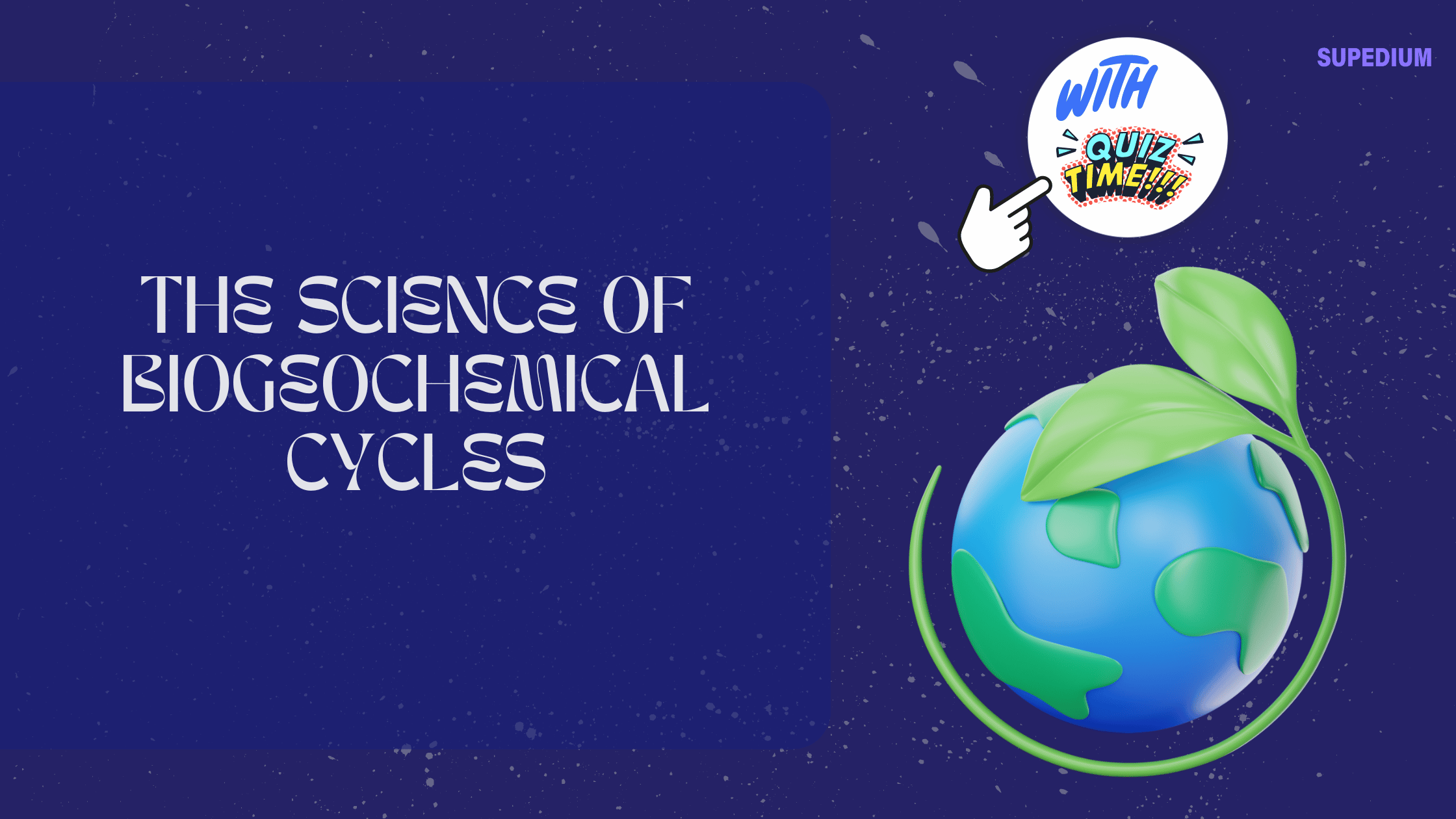Table of Contents
![]()
Biogeochemical cycles are crucial processes that sustain life on Earth by recycling essential elements through the atmosphere, lithosphere, hydrosphere, and biosphere. These cycles involve complex interactions between living organisms and their environments, maintaining ecosystem balance and supporting biodiversity. Understanding these cycles is essential for addressing environmental challenges and managing natural resources.
I. Introduction
Definition of Biogeochemical Cycles
Biogeochemical cycles refer to the movement and transformation of elements and compounds between living organisms and the physical environment. They encompass biological, geological, and chemical processes that facilitate the recycling of essential nutrients. By ensuring the continuous availability of vital elements, these cycles are fundamental to life on Earth.
Overview of Major Cycles
There are several key biogeochemical cycles, each focusing on different elements:
- Carbon Cycle: Describes the movement of carbon through the atmosphere, biosphere, hydrosphere, and lithosphere.
- Nitrogen Cycle: Covers the transformation and movement of nitrogen through the environment.
- Phosphorus Cycle: Involves the circulation of phosphorus between the earth’s crust and living organisms.
- Water Cycle: Outlines the movement of water through evaporation, condensation, precipitation, and runoff.
- Sulfur Cycle: Details the flow of sulfur through the atmosphere, lithosphere, and biosphere.
Significance in Environmental Science
Understanding biogeochemical cycles is critical for assessing their impact on climate change, ecosystem health, and human activities. These cycles influence greenhouse gas concentrations, nutrient availability, and the overall stability of ecosystems.
II. The Carbon Cycle
Key Components
The carbon cycle involves several key components:
- Atmosphere: Contains carbon in the form of carbon dioxide (CO₂) and methane (CH₄).
- Biosphere: Includes all living organisms that absorb, utilize, and release carbon.
- Lithosphere: Consists of carbon stored in soil and fossil fuels like coal, oil, and natural gas.
- Hydrosphere: Involves carbon dissolved in oceans, lakes, and rivers.
Processes Involved
- Photosynthesis: Plants convert atmospheric CO₂ into organic compounds, storing carbon in biomass.
- Respiration: Organisms release CO₂ back into the atmosphere through metabolic processes.
- Decomposition: Microorganisms break down dead organisms, releasing carbon into the soil and atmosphere.
- Combustion: Burning fossil fuels releases stored carbon into the atmosphere.
- Carbon Sequestration: Carbon is captured and stored in forests, soils, and oceans.
Human Impact
Human activities significantly affect the carbon cycle. The combustion of fossil fuels for energy releases large amounts of CO₂, contributing to global warming. Deforestation reduces the number of trees available to absorb CO₂, further exacerbating climate change. Ocean acidification, caused by increased CO₂ levels, impacts marine life and ecosystems.
Case Studies and Current Research
Research on climate change models and carbon offset projects is ongoing. These studies aim to understand the long-term effects of carbon emissions and develop strategies to mitigate their impact, such as reforestation and carbon capture technologies.
III. The Nitrogen Cycle
Key Components
The nitrogen cycle involves:
- Atmosphere: Dominated by nitrogen gas (N₂), which is inert and not directly usable by most organisms.
- Soil: Contains various nitrogen compounds such as ammonium (NH₄⁺) and nitrate (NO₃⁻).
- Plants: Absorb nitrogen compounds from the soil to build proteins and other essential molecules.
- Animals: Obtain nitrogen by consuming plants and other animals.
Processes Involved
- Nitrogen Fixation: Converts atmospheric N₂ into ammonia (NH₃) or related compounds, often facilitated by bacteria or industrial processes.
- Nitrification: Bacteria convert ammonia into nitrites (NO₂⁻) and then nitrates (NO₃⁻), which are more accessible to plants.
- Assimilation: Plants take up nitrates and incorporate them into organic molecules.
- Ammonification: Decomposition of organic matter releases ammonia back into the soil.
- Denitrification: Bacteria convert nitrates back into N₂ gas, returning it to the atmosphere.
Human Impact
Human activities, such as the use of synthetic fertilizers and industrial nitrogen fixation, have altered the nitrogen cycle. Excess nitrogen from fertilizers can lead to eutrophication in water bodies, causing harmful algal blooms and hypoxic conditions.
Case Studies and Current Research
Studies focus on improving nutrient management strategies and restoring nitrogen-depleted ecosystems. Researchers also investigate methods to reduce nitrogen runoff and its environmental impacts.
IV. The Phosphorus Cycle
Key Components
The phosphorus cycle involves:
- Lithosphere: Contains phosphorus in rocks and minerals.
- Soil: Phosphorus becomes available to plants through weathering of rocks.
- Water Bodies: Phosphorus is present in lakes, rivers, and oceans as phosphate.
- Organisms: Phosphorus is an essential nutrient for plants and animals.
Processes Involved
- Weathering of Rocks: Releases phosphorus into the soil and water systems.
- Absorption by Plants: Plants take up phosphate from the soil for growth.
- Consumption by Animals: Animals obtain phosphorus by eating plants or other animals.
- Decomposition: Dead organisms release phosphorus back into the soil.
- Sedimentation: Phosphorus accumulates in sediments, eventually forming new rocks.
Human Impact
Phosphorus cycling has been significantly impacted by human activities. Phosphate mining and agricultural runoff contribute to excess phosphorus in water bodies, leading to eutrophication.
Case Studies and Current Research
Research includes phosphorus recovery and recycling technologies, and strategies to mitigate the impact of excess phosphorus on freshwater and marine ecosystems.
V. The Water Cycle
Key Components
The water cycle involves:
- Atmosphere: Contains water vapor that contributes to cloud formation.
- Hydrosphere: Includes oceans, lakes, rivers, and other bodies of water.
- Cryosphere: Consists of ice caps and glaciers.
- Lithosphere: Involves groundwater stored in aquifers.
Processes Involved
- Evaporation: Water changes from liquid to vapor and enters the atmosphere.
- Condensation: Water vapor cools and forms clouds.
- Precipitation: Water returns to Earth as rain, snow, or hail.
- Infiltration and Percolation: Water soaks into the ground and replenishes groundwater.
- Runoff: Water flows over the surface and returns to bodies of water.
Human Impact
Human activities such as water consumption, pollution, and land use changes affect the water cycle. Climate change impacts precipitation patterns and water availability, while pollution alters water quality.
Case Studies and Current Research
Current research focuses on water scarcity, management solutions, and the effects of climate change on the water cycle. Innovations in water conservation and purification technologies are being explored to address these challenges.
VI. The Sulfur Cycle
Key Components
The sulfur cycle involves:
- Atmosphere: Contains sulfur compounds like sulfur dioxide (SO₂) and hydrogen sulfide (H₂S).
- Lithosphere: Includes sulfur stored in minerals and rocks.
- Biosphere: Involves sulfur in living organisms.
- Hydrosphere: Contains sulfate and other sulfur compounds in water bodies.
Processes Involved
- Sulfide Oxidation: Converts sulfide minerals to sulfate.
- Sulfate Reduction: Microorganisms reduce sulfate to sulfide in anaerobic conditions.
- Assimilation: Plants and microorganisms incorporate sulfur into organic molecules.
- Volcanic Eruptions: Release sulfur compounds into the atmosphere.
- Acid Rain Formation: Sulfur dioxide reacts with water vapor to form sulfuric acid.
Human Impact
Human activities, such as industrial emissions and fossil fuel combustion, release sulfur dioxide into the atmosphere, leading to acid rain. This can damage ecosystems and contribute to respiratory problems in humans.
Case Studies and Current Research
Efforts to mitigate acid rain include regulatory measures to reduce emissions and technological advancements in industrial processes. Research also focuses on sulfur management strategies and their effects on climate change.
VII. Interconnections Among Cycles
The Integrated Nature of Cycles
Biogeochemical cycles are interconnected, with changes in one cycle often affecting others. For example, increased carbon dioxide from the carbon cycle can influence nitrogen and water cycles by altering precipitation patterns and nutrient availability. Understanding these interactions is crucial for effective environmental management.
Case Studies of Interconnected Cycles
Land use changes, such as deforestation and urbanization, impact multiple biogeochemical cycles simultaneously. Pollution can affect carbon, nitrogen, and phosphorus cycles, leading to complex environmental challenges that require integrated solutions.
VIII. Conclusion
Summary of Key Points
Biogeochemical cycles are essential for sustaining life and maintaining environmental balance. Each cycle—carbon, nitrogen, phosphorus, water, and sulfur—plays a unique role in recycling nutrients and supporting ecosystems.
The Importance of Understanding Biogeochemical Cycles
A comprehensive understanding of these cycles is vital for developing effective environmental policies, managing natural resources, and addressing global challenges such as climate change and pollution.
Future Directions in Biogeochemical Research
Future research will focus on innovations and technologies to better manage biogeochemical cycles. Studies will continue to explore the impacts of human activities, climate change, and ecosystem restoration, aiming to enhance our ability to sustain and protect the environment for future generations.





Be the first to comment